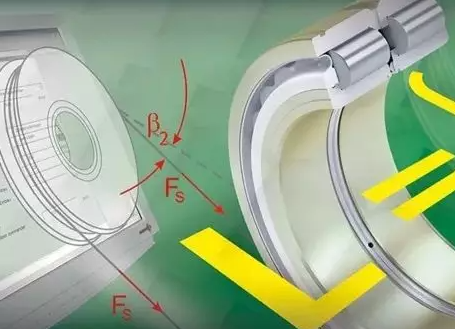Causes of bearing noise
1. Vibration caused by the change of the number of loaded rolling elements. When a radial load is loaded on a bearing, the number of loaded rolling elements will change slightly during operation, resulting in the deviation of the load direction. 2. Local damage due to operation or installation errors, a small part of bearing raceways and rolling elements may be damaged. During operation, damaged bearing components will produce specific vibration frequencies. Vibration frequency analysis can identify damaged bearing components. This principle has been applied to condition monitoring equipment to monitor bearing damage. 3. Accuracy of relevant parts. When the inner and outer rings of the bearing are closely matched with the bearing seat or transmission shaft, the inner and outer rings of the bearing may be deformed due to improper matching with the shape of adjacent parts. If deformation occurs, vibration and noise may occur during operation. 4. If the equipment operates in a polluted environment, impurities may enter the bearing rolling element and produce vibration sound. In this case, a disturbing noise can usually be heard. 5. The causes of noise produced by other rolling bearings are complex. One is the wear of the mating surfaces of the inner and outer rings of the bearing. Due to this wear, the matching relationship between the bearing and the shell and between the bearing and the shaft is damaged, resulting in the axis deviation from the correct position. The shaft makes abnormal noise when moving at high speed.
In addition, insufficient bearing lubrication, dry friction and bearing breakage will produce abnormal sound. Bearing wear, cage looseness and damage will also produce abnormal noise.

Different bearings have different noise levels?
1. The noise of ball bearing is lower than that of roller bearing, and the (friction) noise of bearing with less sliding is lower than that of bearing with more sliding; If there are many balls, the outer ring is thick and the noise is small; 2. The noise of bearings with solid cages is relatively lower than that of bearings with stamping cages; 3. The noise of bearings with plastic cages is lower than that of bearings with the above two cages; 4. The noise of bearings with high precision, especially those with higher rolling element precision, is relatively lower than that of bearings with low precision; 5. The noise of small bearings is relatively lower than that of large bearings.
Of course, this is true in theory. In practical application, the size of noise is also affected by many factors.

Experts say - 30 reasons for bearing noise
1. Impurities in grease;
2. The cage is broken;
3. The bearing raceway is rusty;
4. Bearing noise (interference from external vibration source);
5. Unqualified ferrule raceway (manufacturer's problem);
6. The clearance of the bearing is too small or too large (problem of the manufacturer);
7. The diameter of the seat hole is too small (resulting in excessive bearing temperature);
8. Eccentric sealing ring (contact with adjacent parts and friction);
9. There are sundries in the bearing seat hole (residual chips, dust particles, etc.);
10. Bearing noise (caused by roller end face or steel ball slipping);
11. The shaft shoulder is too large (touching the seal of the bearing and causing friction);
12. The clearance of labyrinth seal ring is too small (friction with shaft);
13. The teeth of the lock washer are bent (touching the bearing and rubbing);
14. The shoulder of the seat hole is too large (it distorts the seal on the bearing);
15. The position of the oil slinger is inappropriate (touching the flange cover and rubbing);
16. Impurities such as sand or carbon particles are mixed into the bearing to play the role of abrasive;
17. Wear of steel ball and raceway (unqualified grinding or bumping of products);
18. The thermal elongation of the shaft is too large (the shaft bears static and indeterminate axial additional load);
19. The bearing is flattened by the seat hole (the roundness of the seat hole is not good, or the seat hole is not straight);
20. Dirt such as water, acid or paint is mixed into the bearing to corrode;
21. The fit between the bearing and the shaft is too loose (the diameter of the shaft is too small or the tightening sleeve is not tightened);
22. The clearance of the bearing is too small and too tight during rotation (the tightening sleeve is too tight);
23. There are pressure pits on the steel ball or roller (caused by knocking the bearing with a hammer during installation);
24. The bearing is discolored and deformed by heating (caused by removing the bearing by heating with a spray gun);
25. The shaft is too thick, which makes the actual fit too tight (resulting in excessive bearing temperature or noise);
26. Insufficient lubrication (oil level is too low and improper storage leads to oil or grease leakage through the seal);
27. The sizing block on the bottom surface of the bearing seat is uneven (resulting in seat hole deformation and even crack of the bearing seat);
28. The diameter of the bearing seat hole is too large and the actual fit is too loose (the bearing temperature is too high and the outer ring slips);
29. The bearing seat hole becomes larger (the bearing seat hole of non-ferrous metal is supported larger, or becomes larger due to thermal expansion);
30. The shaft bears additional load (the shaft bears axial tightness, or there are two fixed end bearings on one shaft);